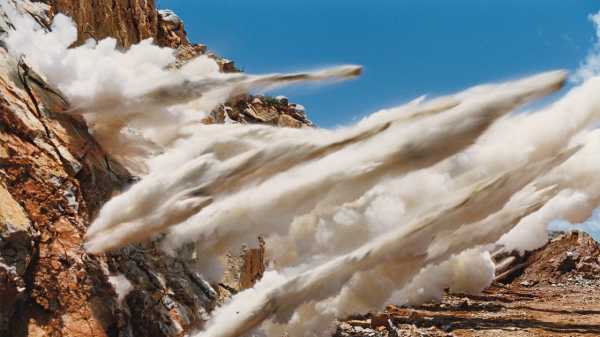
Sometime in the nineteen-eighties, riding the monorail into Tokyo, Naoya Hatakeyama had an epiphany about limestone—namely, that it was everywhere, except in the vast holes where it used to be. Blast after blast, truckload by truckload, humanity had embarked on an elaborate limestone-relocation project, otherwise known as “construction.” What once belonged to the landscape had been prized out and spun into cities. In a violent reverie, Hatakeyama imagined pulverizing every building and highway in Japan. If he could return every last spoonful of dust to the quarry from whence it came, he could restore the land, and, along with it, a vision of the past. “The quarries and the cities,” he later wrote, “are like negative and positive images of a single photograph.”
“#06222, Santa Fe, Mexico City,” 2015, from the series “Mexico City.”
Hatakeyama’s career could be described as a decades-long quest for that photograph. He takes pictures of the quarries and the cities, and of the forgotten, forbidding places that bind them: factories, roads, rivers, tunnels. His work suggests that we’ve never fully countenanced the upheaval caused by industry. We see that the landscape is contused and pockmarked; we see that the skyline shimmers; but we’ve lost sight of how the former yields the latter. “Excavating the Future City,” a photo book accompanying a retrospective at the Minneapolis Institute of Art, imposes geological time on our human scale. Detached and unsentimental, it trains the eye to see prehistorically. Looking at a clutch of high-rises, you’ll think of the ore that the buildings are made from, rather than of the condos within.
“#29214,” 1990, from the series “Lime Hills.”
“#13218, Gaona Armenta, Mexico City,” 2015, from the series “Mexico City.”
Photographing quarry explosions, for instance, Hatakeyama captures the instants when hundreds of millions of years of hard-won solidity are undone by the push of a button. The limestone shatters into a storm of debris, raining sediment. Zephyrs of smoke surge between shards of rock. For Hatakeyama, this is like the moment of conception. It’s where buildings come from. In limestone, he sees the mineral past and the urban future; the blasts are as generative as they are destructive. “When explosives experts described the thrill they feel at the moment of detonation,” he writes, it reminded him of “the pleasure a farmer feels when he turns over the earth with his plow.” Quarry factories, far from being harbingers of doom, are sublime in their own way: their latticework of corrugated chutes, conveyor belts, and steel beams offers an obscure kind of hope.
“#048,” 2006, from the series “Slow Glass/Tokyo.”
Hatakeyama is no less meditative within the city limits. On rainy nights in Tokyo, he sets up a special camera with a glass-plated front, which he built himself. The glass catches globules of water, which refract the foggy light from billboards and apartment towers: in every droplet, a little city. Elsewhere, he captures the banks of fluorescent lights in Tokyo’s stairwells and passageways, all of them evenly spaced, soaring upward into the night, the world’s most orderly constellations. Hatakeyama is drawn to patterns and intervals, the city’s hidden geometry. He has said that everything in his field of vision reduces to three categories: things standing up, things lying down, and holes. You want to press him on this—surely, there’s more to the world than verticality, horizontality, and negative space. But then you look out the window, and that pretty much settles it.
“Untitled/Osaka,” 1998.
“Untitled/Osaka,” 1999.
In 2011, the Tōhoku tsunami tore through Hatakeyama’s coastal home town, Rikuzentakata, flattening his family home and claiming his mother’s life. In his devastation, Hatakeyama was one of the first photographers to depict the wreckage. He wanted to alleviate the horrible sense of void he’d felt on his way back home, when he moved forward in perfect ignorance, not knowing what he would see. His pictures of the aftermath—and, later, the effort to rebuild—are colored by his memories and by his unnerving farsightedness. “Is the landscape that now appears in Rikuzentakata,” he writes, “not the result of the annihilation of our current era by an age before history?”
“#39410,” 1994, from the series “Lime Hills.”
Concentrating on the rudiments of city life, Hatakeyama is able to glimpse a fact so obvious that it’s rarely mentioned: “There has never been a time in our history when the space about us was so fraught with artificial objects.” We walk around every day in complex, unnatural environments that we built by wresting raw material from the ground. A city, Hatakeyama reminds us, is just a product of human intervention, no more permanent than the lime hills it came from. Seeing that construction in its totality, in Hatakeyama’s photographs, forces us to experience, as he puts it, a simultaneous “fear and admiration for the world of things.”
“Takatacho-Morinomae,” 2011, from the series “Rikuzentakata.”
“#23514,” 1988, from the series “Lime Hills.”
“#22916,” 1988, from the series “Lime Hills.”
“#38610,” 1993, from the series “Lime Hills.”
“#41408,” 1994, from the series “Lime Works.”
“#0909,” 2008, from the series “Yamate Dōri.”
“#3203,” 2008, from the series “Yamate Dōri.”
“Kohlenwäsche Number 2,” 2003, from the series “Kohlenwäsche.”
“#6607,” 1999, from the series “Underground Water.”
“#6202,” 1998, from the series “Underground Water.”
“#05070,” 1998, from the series “Blast.”
advertisement
Sourse: newyorker.com






